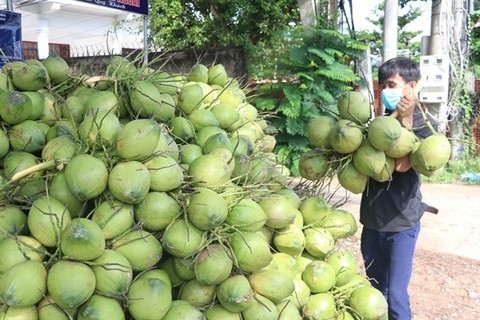
Việt Nam's fresh coconuts. China is a potential market for Vietnamese coconuts with demand of 2.6 billion fresh coconuts each year. — VNA/VNS Photo
Việt Nam's fruit and vegetable export value reached over US$3.8 billion in the first seven months of 2024, up 23.4 per cent compared to the same period in 2023.
In July alone, the fruit and vegetable export value surged by 18 per cent year-on-year to $477 million.
The Việt Nam Fruit and Vegetable Association said that since the beginning of 2024, the strong increase in market demand has pushed the export value of fruits and vegetables up.
The strong growth in exports showed that the quality of Vietnamese fruits and vegetables has improved to meet the export markets' requirements.
Meanwhile, Việt Nam's fruit imports also increased strongly. In the first seven months, the country spent over $1.2 billion to import fruits, an increase of 12.7 per cent over the same period last year. This import value reached about $200 million in July.
During the seven months, the imported fruits mainly came from China ($397 million, up 27 per cent), the US ($206 million, up 14 per cent) and Australia ($57 million, up 76.6 per cent). Việt Nam also imported a large volume of fruits from other countries, such as South Korea, Japan and Thailand, according to the association.
The products imported in great quantity in the seven months were all temperate fruits, including apples, pears, pomegranates, grapes, and plums, alongside vegetables.
The association said Việt Nam only imported the products that the domestic market does not have, or has very little supply.
However, Việt Nam's fruit and vegetable industry still gained a trade surplus of almost $2.6 billion in the first seven months.
Large exports to north east Asian market
Notably, Đặng Phúc Nguyên, general secretary of the Việt Nam Fruit and Vegetable Association, said that in the export structure, the northeast Asian countries such as China, South Korea and Japan, accounted for 80 per cent of the export value. The remaining 20 per cent came from Europe, the US, Australia and the Middle East.
Two countries, China and South Korea, had the highest export turnover. Of which, China was the leading market, accounting for 64 per cent of the total export value with $2.1 billion, an increase of 22 per cent year on year.
The second largest export market for Vietnamese fruits and vegetables was South Korea, with the export value to this market at $164 million in the first seven months, up 57.9 per cent over the same period in 2023.
South Korea is the export destination for Vietnamese dragon fruits, mango and grapefruit.
The United States was the third largest export market for Vietnamese fruit and vegetable exports, with a value of about $157 million, up 32.4 per cent over the same period last year, showing it still has great potential for fruit and vegetable exporting countries, including Việt Nam.
Meanwhile, Việt Nam has exported dragon fruit, mango and longan to Japan. The two countries are negotiating to export Vietnamese grapefruit to Japan in the future.
"In the future, northeast Asia will be a strategic market for Vietnamese fruits and vegetables," Nguyên said.
China is a populous market with high demand for fruits and vegetables and it is also a traditional customer for many kinds of Vietnamese fruits.
Meanwhile, Japan and South Korea are also populous countries with high incomes and great demand for quality agricultural products and fruits.
China, Japan, and South Korea are members of the Regional Comprehensive Economic Partnership (RCEP). This is a free trade agreement between ASEAN countries and China, South Korea, Japan, Australia and New Zealand, effective from January 1, 2022, stipulating tariff elimination for 90 per cent of products within 20 years.
When exporting to these markets, Vietnamese enterprises not only benefit from the tariffs but also from reduced transportation and logistics costs. They maintain the quality of agricultural products compared to transporting to distant markets such as the EU and the US.
"Joining the RCEP, the import taxes are reduced, so countries will erect technical barriers. Those barriers force the fruit exporting enterprises to update regularly the export regulations of northeast Asian countries to promptly respond," Nguyên said.
New chance for fresh coconut
In the first seven months of 2024, durian still had the highest export turnover in the fruit industry, with a turnover of about $1.7 billion. However, Nguyên said that due to the durian crop being out of season, the export turnover of vegetables and fruits in July was lower than in previous months.
Phùng Đức Tiến, Deputy Minister of Agriculture and Rural Development, said that Việt Nam has allowed official export for 11 kinds of fruits and vegetables to China, including watermelon, mangosteen, durian, fresh banana, sweet potato, dragon fruit, rambutan, mango, lychee, longan and jackfruit.
At present, the two countries are completing all procedures to sign soon a protocol on quarantine requirements for fresh coconuts, which will open up export prospects for the Vietnamese fruits.
China would be a huge market for Vietnamese coconuts with a demand of 2.6 billion fresh coconuts and of 1.5 billion coconuts for processing each year, said Trần Văn Đức, chairman of Bến Tre Coconut Investment JSC.
With short transportation time and low costs, Vietnamese coconuts would be highly competitive.
Currently China's own coconut output only meets about 10 per cent of domestic consumption demand.
Therefore, Nguyên predicted that if the protocol is signed and local businesses exploit the advantages from this protocol, Việt Nam's coconut industry can earn $300 million more from the Chinese market. — VNS